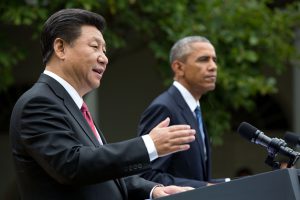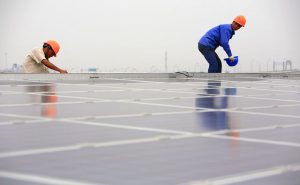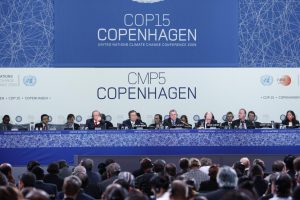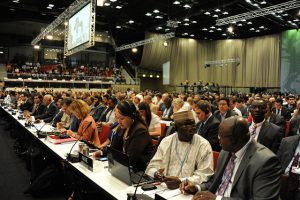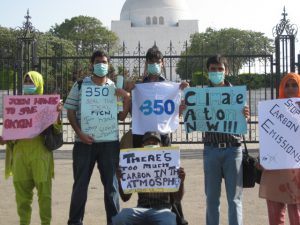Teng Fei (TF): Both the UNFCCC and UNEP reports stated the same basic fact: the INDCs are inadequate if the 2C limit is not to be breached.
So we still need talks and coordination at the international level, to reduce these gaps and bring about a better consensus on the fairness principle.
The current bottom-up system of submitting climate plans means each nation chooses its own definitions of fairness. So I think the only course of action is for everyone to look at their own emission reduction plans, development needs and key development targets, to find the motivation and potential for bigger cuts.
For example air pollution is currently a big problem for China. An early resolution to that problem would also help increase China’s emission cuts. It’s the same for other countries. For example energy security issues in Japan, India as well has its own important domestic development targets.
Also there’s the potential for breakthroughs in cooperation on low-carbon technology. For example reducing the cost of crucial technologies so developing nations can make use of them. That would also result in more potential for emissions cuts.
Risk management is also very important and needs more work. Estimates that we can stick to the 2C limit range from 50% to two-thirds, but climate change policy decisions may need to consider a worst case outcome. What is the worst case humanity can cope with? Can we accept a 3% or 4% chance of a 4C or 5C temperature increase? Humanity needs to manage the small but possible risk of catastrophic outcomes.
CD: How do you think China should decarbonise?
TF: There are three aspects to this: The first is increasing energy efficiency, such as using better technology and structural changes to bring about sustained annual improvements in energy efficiency growth per GDP of 4%.
The second is to decarbonise the power sector by increasing the share of renewables and nuclear energy in the power mix, and using carbon capture and storage in fossil-fuel power generation to reduce the intensity of emissions. Achieving those targets will ensure that by 2050, CO2 emissions per unit of electricity will be 90% lower than in 2010.
The third is to increase electrification, particularly in industry, transportation, and buildings. We should replace industrial coal-fired furnaces with electric ones, increase the use of electric vehicles, and use electricity more for heating and hot water.
The second and third methods are closely linked. First we need low-carbon power generation, then we have to increase electrification in order to reduce direct emissions (from heavy industry).
TF: Falling prices of fossil fuels alone are not helpful for low-carbon development. If those prices stay low in the long-term the larger price differential with non-fossil sources of energy will mean either development of non-fossil energy will be hampered, or the government will have to take on the financial costs of subsidising development.
But crisis brings opportunity to make some important changes. If fossil fuel prices remain low, the government can change pricing mechanisms.
Last year our research in partnership with the Natural Resources Defense Council found that coal has external costs of 260 yuan per tonne – approximately 50% of what coal costs today. But currently only 50 yuan of external costs are factored into the coal price – one fifth of total externalities. Falling prices give government the opportunity to change pricing mechanisms to better reflect social and environmental costs.
TF: There are very clear signals. The 2C goal means that 80% of China’s identified fossil fuel reserves must remain in the ground. So for the fossil fuel industry, continued investment in coal and coal power will result in stranded assets and unavoidable writedowns.
Meanwhile, to achieve an emissions peak in 2030, investment in non-fossil sources of energy will increase to twice 2010 levels by 2020, and to three times 2010 levels by 2030. The International Energy Agency’s 2014 World Energy Investment Outlook estimated that the 2C limit will require investment in low-carbon power generation and energy efficiency to increase three-fold and eight-fold on 2013 levels by 2035. That’s a very clear policy signal for investors.
Also the green and low-carbon sector will become a new point of economic and employment growth. That indicates companies and investors should invest more in green and low-carbon fields.
Although the signals are clear, we still need appropriate policies to send concrete price and market signals if we are to achieve climate targets. For example carbon markets and pricing, environmental taxes, and so on.
TF: Overall the plan stresses the role of the markets, for example using energy rights and carbon markets.
What’s going to be interesting is how the government uses markets to achieve policy goals, rather than continuing to hand down targets to be met.
And the relationship between government and the markets still needs to be clarified. For example in carbon markets – can the government step back and reduce intervention, providing only necessary services, rather than doing everything from policy design to allocating emissions quotas, from deal-making to third-party verification? Micromanaging by government would not help the market play a guiding role.

